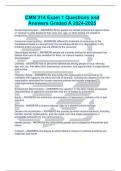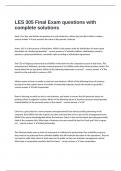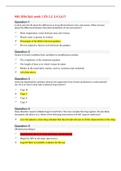CMN 214 Exam 1 Questions and
Answers Graded A 2024-2025
Access Discrimination - ANSWERS-When people are denied employment opportunities,
or "access" to jobs, based on their race, sex, age, or other factors not related to
productivity.
Consumer racial profiling - ANSWERS-differential treatment of consumers in the
marketplace based on race/ethnicity that constitutes denial of or degradation in the
products and/or services that are offered to the consumer
Discouraged workers - ANSWERS-people not currently looking for work because they
believe there are no jobs available for them, for various reasons, including
discrimination
Diversity - ANSWERS-real or perceived differences among people in race, ethnicity,
age, sex, etc, that affect their experiences, outcomes, and opportunities in organizations
and society.
Diversity climate - ANSWERS-the tone set by the organizations and sensed by its
members with regard to the value and role of diversity, including the degree to which the
organization advocates fair human resource policies and socially integrates
underrepresented employees
Employment Discrimination - ANSWERS-the valuation in the labor market of personal
characteristics of applicants and workers that are unrelated to productivity
Equity - ANSWERS-the distribution and provision of resources to achieve a fair or just
outcome
Ethnicity - ANSWERS-a shared national origin or a shared cultural heritage
Gender role socialization - ANSWERS-the process by which social institutions, including
families, friends, organizations, and the media, form and shape expectations of
acceptable behaviors for men and women
Identity groups - ANSWERS-the collectivities people use to categorize themselves and
others
Inclusion - ANSWERS-the degree to which different voices of a diverse workforce are
respected and heard
, Intersectionality - ANSWERS-the connected nature of various social identities, such as
race, gender, and class and potential for overlapping and interconnected systems of
discrimination based on those identities
myth of meritocracy - ANSWERS-the idea that societal resources are distributed
exclusively or primarily on the basis of individual merit
participation rates - ANSWERS-the ratio of persons age 16 and over who are working or
looking for work divided by the populations of persons age 16 and over`
productive characteristics - ANSWERS-such things as performance, education, skills,
and tenure that are generally construed as legitimate reasons for differentiation among
employees
Radicalized sexual harassment - ANSWERS-the combination of racial and sexual
harassment, which includes both sexual and racial derogatory behaviors, comments,
and demands directed at a person because of their race and sex.
social class - ANSWERS-ones position in the economic system of production,
distribution, and consumption of goods and services in industrial societies, often
measured by education, income, or wealth.
structural or systemic racism - ANSWERS-the ways in which society foster racial
discrimination through mutually reinforcing systems, including public policies,
institutional practices, cultural representations, and other norms that work in reinforcing
ways to perpetuate group inequity
Treatment discrimination - ANSWERS-when people are employed but are treated
differently once employed, receiving fewer job-related rewards, resources, or
opportunities than they should receive based on job-related criteria
Underemployed - ANSWERS-workers employed at less than their full employment
potential, including those working part-time, temporary, or intermittent jobs but desiring
regular, full-time work; those working for lower wages than their skills would imply or in
positions requiring considerably lower skills than they possess; and those involuntarily
working outside their fields
Ambivalent sexism - ANSWERS-the simultaneous holding of both hostile and
"benevolent" sexist beliefs about women; for example, "women are incompetent at
work" and "women must be protected."
benevolent sexism - ANSWERS-a set of interrelated attitudes toward women that are
sexist while they are perceived as positive by the attitude holder






